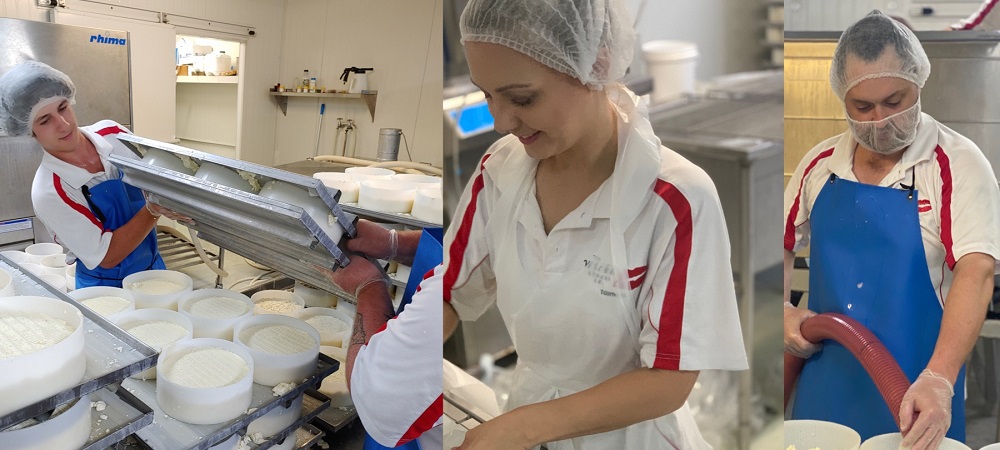From Thomastown to Your Table: The Excellence of Floridia Cheese Melbourne
From Thomastown to Your Table: The Excellence of Floridia Cheese Melbourne
Blog Article
Opening the Keys of Artisanal Cheese Making: A Detailed Do It Yourself Guide
In the realm of cooking craftsmanship, artisanal cheese making stands as a testimony to the delicate balance between custom and development. Each step in the procedure, from choosing the ideal milk to refining aging strategies, holds within it a wealth of expertise passed down with generations. As we embark on this journey to debunk the art of developing beautiful cheeses, we are confronted with a tapestry of skills and keys waiting to be untangled. Join us as we discover the details of this ancient craft, where art, perseverance, and science converge to produce tastes that tantalize the senses.
Picking the Right Milk
When beginning on the trip of artisanal cheese making, the selection of milk plays a crucial role in identifying the quality and attributes of the end product. The sort of milk selected affects the taste, appearance, and overall account of the cheese. Raw milk, straight from the pet, is chosen by several artisanal cheesemakers due to its distinct blend of enzymes, bacteria, and taste compounds. Making use of raw milk comes with risks and guidelines, making sterilized milk a more secure alternative for beginners.
Furthermore, the source of the milk, whether from cows, goats, lamb, or buffalo, contributes unique tastes and qualities to the cheese. Each type of milk brings its very own nuances, permitting for a broad array of cheese varieties to be crafted based on the picked milk.
Culturing and Coagulating
To initiate the cheese-making procedure, the essential steps of culturing and coagulating have to be thoroughly implemented to change milk right into curds and whey. Culturing involves introducing beneficial germs to the milk, which then starts the fermentation process. These bacteria transform lactose (milk sugar) into lactic acid, creating the acidic atmosphere required for coagulation. The kind of culture used can considerably impact the flavor, appearance, and ripening of the final cheese product.

The timing and temperature level control during culturing and coagulation are vital aspects that affect the last result of celebrity. Proper execution of these actions is vital to ensure the wanted texture, flavor, and consistency of the artisanal cheese being generated.
Draining and Pushing Curds
After the milk proteins have coagulated and the curds have been cut to launch whey, the following crucial step in artisanal cheese making includes draining and pushing the curds to attain the wanted appearance and uniformity of the last cheese product. Draining pipes is the procedure of dividing the curds from the whey. This can be done by transferring the curds into a cheesecloth-lined bowl-shaped sieve or mold and permitting the whey to drain off normally. The time for draining pipes can vary depending on the kind of cheese being made and the wanted moisture material.
Once the curds have adequately drained pipes, the next step is pushing. Pressing helps remove any remaining whey and compacts the curds to create a solid cheese wheel. Pressing can be done using specialized cheese presses that use mild and consistent stress over a period of time. The duration and pressure used throughout pressing will certainly affect the last appearance of celebrity, from luscious and soft to tough and company. Proper pushing and draining pipes are vital actions that dramatically impact the quality and qualities of the artisanal cheese being created.
Aging and Flavor Methods
Executing thorough aging and flavoring strategies is critical in boosting the depth and complexity of artisanal cheeses, boosting their taste profiles to beautiful levels of improvement and elegance. Aging plays an important duty in creating the special flavors and textures that distinguish artisanal cheeses.
Flavoring techniques likewise contribute significantly to the final taste of artisanal cheeses. Cheesemakers might pick to present extra flavors by including active ingredients such as herbs, seasonings, and even fruits right into the cheese throughout the production procedure. Furthermore, some cheeses are cleaned or rubbed with various liquids, such as salt water or alcohol, to enhance their textures and tastes.
Covering and Saving Cheeses

Final Thought
In verdict, grasping the art of artisanal cheese making entails carefully picking the right milk, following accurate culturing and coagulating processes, draining and pushing curds successfully, and using numerous aging and flavor techniques. By complying with these actions faithfully and with interest to information, you can create your very own scrumptious and distinct cheeses in your home. Bear in mind to wrap and store your cheeses appropriately to make sure optimum taste and texture development. Delighted cheese making!
Each kind of milk brings its very own subtleties, permitting for a vast array of cheese ranges to be crafted based on the selected milk.After the milk proteins have coagulated and the curds have been cut to release whey, the next important step in artisanal cheese making involves draining pipes and pushing the curds to attain the wanted appearance and uniformity of the last cheese product. Many cheeses ought to be wrapped in wax paper or cheese paper to why not find out more allow them to breathe while protecting them from drying out. For cheeses that require to continue aging, such as bloomy skins or washed rinds, guarantee they are saved in a trendy setting like a cheese cavern or a refrigerator set to the ideal temperature level. By paying focus to the covering and storage of artisanal cheeses, cheese makers and fanatics can protect the integrity of these delicacies and totally enjoy their complex tastes.
Report this page